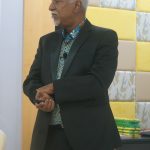- August 17, 2019
- Posted by: Shivani Chopra, CFA
- Category:BLOG, Events
Contributed By: Meera Siva, CFA
The markets may be likened to a casino – there is a lot of luck (or bad-luck) but a skillful player knows how to make the most of the cards dealt and come out ahead. So, there are many lessons a finance professional could pick up from the world of card games. Especially bridge game that has no betting. Warren Buffet famously said that he would not mind being in jail if his cell mates will play Bridge. Need we say more about its benefits to finance professionals?

At the CFA Society India, Chennai Chapter’s speaker event on August 9, 2019, Sunil Varghese spoke on this exciting game and its benefits. Sunil is an entrepreneur, TedX Speaker, Bridge Guru, Magician, Mentor for StartUps, Faculty and consultant. Did I say he is a magician?
He is also the Founder of MasterMind, which uses magic and innovative techniques – from launching a FMCG product in an unforgettable way or to drive the message home at the end of heavy seminars or sales conferences. He has been running a small-scale engineering firm for 28 years. Sunil holds a PGDM from IIM-Ahmedabad and a mechanical engineering degree from the College of Engineering, Thiruvanandapuram.
Why Bridge?
Bridge mirrors life (and finance) and playing it develops skills – risk analysis, probability, decision-making with incomplete information, planning and choosing the best from among alternatives. The game helps tap the right and the left brain and hence keeps the brain agile. Various studies show it helps enhance concentration, alertness and analytical ability. As it is a team game (played as two) it also helps understand human nature and psychology.
Unlike chess that takes a long time, the game is short (about 7 minutes). The game is touted by many professionals and leaders including Bill Gates. Many countries such as China, Norway and Holland encourage teaching the game in school for its many benefits.
The game
Bridge is played with a regular deck of 52 cards. There are 2 players. North and South form a team and they play East-West. Players are given 13 cards each. Teams must not talk to each other. The aim is to win most ‘tricks’ (there are 13 total) by having your/your team-mate’s card as the highest ranked one.
There are further variants to the game, with one player playing open (giving an advantage to their team mate). And there is also trump.
To illustrate, the group played two rounds of game. And after each, the cards dealt were analyzed to figure out which strategy would have worked well and what it the most one could have got. For example, while everyone played the highest card (A), that was not quite the best strategy. Looking at how to make the lower ranked card (for example a 10) win a trick is what one had to think about. The important thing is to have a strategy first that one has put some thought into (for example, which cards would one lead the game with, which ones to risk when there is uncertainty).
Besides having a strategy and sticking to it (if it is rational, your teammate may also have the same strategy and there is alignment), being mindful and paying attention to what cards were played helps one redo the strategy and take some calculated risks. For example, the other team may play their hands differently and your original idea may not be tenable. You need to pivot, again with a strategy.
Three, it helps to be objective through this process. All the cards served are unique and there are infinite possibilities. So, it is fresh and old ideas, as in hoping to repeat a playbook from the past, will not get you very far.
What next?
There are many bridge clubs and associations that conduct tournaments. Learning and playing can be a great way to work-out your mind, well into old-age. And the skills you learn are immediately applicable as a finance professionals – be it in assessing risk, making decisions under uncertainty, sticking to a strategy, analyzing why your thesis did not work.



